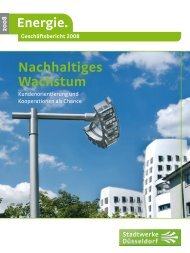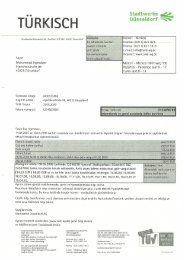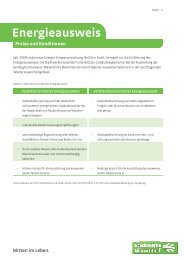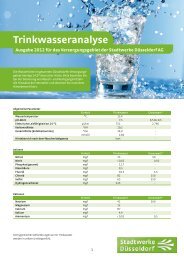Fresh Drinking Water - Stadtwerke Düsseldorf AG
Fresh Drinking Water - Stadtwerke Düsseldorf AG
Fresh Drinking Water - Stadtwerke Düsseldorf AG
You also want an ePaper? Increase the reach of your titles
YUMPU automatically turns print PDFs into web optimized ePapers that Google loves.
<strong>Fresh</strong><br />
drinking<br />
water round<br />
the clock
<strong>Water</strong> –<br />
Essence<br />
of Life<br />
From time immemorial mankind’s<br />
destiny has been closely<br />
linked with water. Civilised<br />
races and empires thrived in<br />
those climes where water was<br />
available. Even nowadays<br />
those regions with a balanced<br />
water supply continue to be<br />
in a more favourable position<br />
than those with little water<br />
or arid regions: industrialization<br />
and the quality of life<br />
clearly depend on the availability<br />
of clean water, and the<br />
latter is by no means evenly<br />
distributed over the globe.<br />
Daily per capita consumption<br />
of drinking water in Germany<br />
is some 128 litres – in contrast,<br />
a family of six in<br />
Ethiopia has a mere 16 litres<br />
at its disposal, and is compelled<br />
to undertake a twohour<br />
walk, carrying the water<br />
home in jerry cans. Only 20%<br />
of all households in the world<br />
are connected up to a central<br />
water system, which is available<br />
as a matter of course to<br />
ourselves.
What is so unique about this<br />
unexceptional substance<br />
“water”?<br />
From a purely chemical<br />
point-of-view water is a<br />
molecule from hydrogen and<br />
oxygen with the formula<br />
H O. This molecule has two<br />
2<br />
poles, that is a positive<br />
partial-charge in the case of<br />
hydrogen and a negative<br />
partial-charge in the case<br />
of oxygen. This so-named<br />
“dipole formation” is<br />
responsible for many of<br />
water’s characteristics.<br />
<strong>Water</strong> is an element, which<br />
exists in nature in three<br />
different forms, the states<br />
of aggregation: as a solid,<br />
a fluid and a gas.<br />
<strong>Water</strong> is the only fluid<br />
which expands when its<br />
temperature drops. Its maximum<br />
density is attained at<br />
+4° Celsius.<br />
The fact that the density of<br />
ice is less than its fluid form<br />
is known as the “density<br />
anomaly”.<br />
Thus water is heavier than<br />
ice. If this were not the case,<br />
water in its various forms<br />
would freeze from the bottom<br />
upwards, leading to destruction<br />
of all underwater<br />
life.<br />
<strong>Water</strong> is an excellent solvent<br />
and, as an accumulator of<br />
heat, a significant climatic<br />
factor as can be seen in the<br />
case of the Golf Stream.<br />
Two thirds of the human<br />
body consist of the substance<br />
water.<br />
We could not live without<br />
water. A human being can<br />
survive for several weeks<br />
without food, but only a few<br />
days without water.
The<br />
Blue<br />
Planet<br />
Almost three quarters of the<br />
earth’s surface (71 percent) is<br />
covered by water, the world’s<br />
total water amounts to some<br />
1.5 billion cubic kilometres.<br />
Not one single drop of this<br />
huge volume of water is lost,<br />
no matter how or for what<br />
purpose the water is used:<br />
Above oceans and land the<br />
surface water is evaporated<br />
by the sun, this then is<br />
changed into water vapour.<br />
The water vapour rises and<br />
condenses to form clouds,<br />
which in their turn pass back<br />
their moisture as rain, dew,<br />
snow or hail, returning once<br />
again to the evaporation<br />
process from the oceans,<br />
lakes and rivers – the neverending<br />
water cycle.<br />
However 97.2 percent of<br />
total water supplies is salt<br />
water and consequently is<br />
not available as drinking<br />
water, at least not directly.<br />
Thus, this leaves 2.8 percent<br />
freshwater, but the bulk of<br />
this is frozen water to be<br />
found in the polar ice caps<br />
and glacier ice as well as<br />
being confined to the atmosphere.<br />
A mere 0.7 percent<br />
of total water on the earth is<br />
immediately available as a<br />
drinking water resource.
With a mean average annual<br />
precipitation of 790 millimetres<br />
Germany is a region<br />
with an abundance of water<br />
(this is the equivalent of a<br />
volume of 790 litres per<br />
square metre). Taking into<br />
account the loss of water due<br />
to evaporation and flowing<br />
to neighbouring countries<br />
and allowing for water flowing<br />
into Germany from the<br />
latter, the water resources<br />
available in our country is<br />
182 billion cubic metres.<br />
The <strong>Water</strong> Budget illustrates<br />
how this volume is split up<br />
between the consumer<br />
groups. It is obvious that<br />
public sector water supplies,<br />
amounting to some 5.7<br />
billion cubic metres annually,<br />
represents only a small proportion.<br />
At the same time it<br />
is apparent from this Budget<br />
that less than a quarter of<br />
the total amount available is<br />
actually used – therefore we<br />
have no problems regarding<br />
lack of water.<br />
Of greater significance is the<br />
threat to drinking water resources<br />
from industry (waste<br />
water from production processes),<br />
agriculture (soil<br />
penetration of fertilisers and<br />
pesticides) and private households<br />
(two million tons of<br />
household cleaners and detergents<br />
annually). The waterworks<br />
are concerned about<br />
having to invest even more<br />
money in the future in order<br />
to be able to supply drinking<br />
water with the required<br />
quality.<br />
With this in mind <strong>Stadtwerke</strong><br />
<strong>Düsseldorf</strong> actively supports<br />
the appeal made by the<br />
Association of <strong>Water</strong>works in<br />
the Rhine Catchment Area<br />
(IAWR):<br />
The quality of surface water<br />
is intended to be sufficiently<br />
high to permit only<br />
natural methods for treatment<br />
of drinking water.
<strong>Düsseldorf</strong> –<br />
the <strong>Water</strong> Supply<br />
The <strong>Stadtwerke</strong> <strong>Düsseldorf</strong><br />
waterworks supply over<br />
600.000 people in <strong>Düsseldorf</strong><br />
and Mettmann with an<br />
average of 150.000 cubic<br />
metres of drinking water a<br />
day – that is 150 million<br />
litres. (As an illustration,<br />
that is the equivalent of<br />
750.000 bath tubs, each<br />
holding 200 litres). The<br />
water supplied can vary between<br />
120.000 cubic metres<br />
on a winter’s day and<br />
200.000 cubic metres on a<br />
hot day in summer.<br />
Even then there are no<br />
problems. Maximum capacity,<br />
otherwise known as<br />
”bottleneck capacity”, is in<br />
the region of 252.000 cubic<br />
metres per day. In addition<br />
to this almost 120.000 cubic<br />
metres are retained in four<br />
reservoirs, where brisk stirring<br />
and intermingling of<br />
the water ensures consistent<br />
quality.<br />
<strong>Water</strong> supply is maintained<br />
by three waterworks:<br />
“Holthausen” waterworks in<br />
the south of the city, where<br />
the laboratory responsible for<br />
quality maintenance and supervision<br />
is located.<br />
“Flehe” waterworks, in the<br />
vicinity of the Heine-University,<br />
which in 1870 was the<br />
nucleus of the central supply<br />
of water in <strong>Düsseldorf</strong>.<br />
“Am Staad” waterworks to<br />
the north of the trade fair<br />
grounds, which is the control<br />
centre for the Rhine leftbank<br />
emergency waterworks<br />
“Lörick”.<br />
In order to ensure adequate<br />
supplies of water the <strong>Düsseldorf</strong><br />
waterworks, for instance,<br />
are linked up with<br />
the Great Dhünn Valley Dam,<br />
the ground water extraction<br />
facility of the lignite mining<br />
area and the waterworks of<br />
other towns in the vicinity.
<strong>Water</strong> Supply in<br />
<strong>Düsseldorf</strong> involves<br />
three distinct stages:<br />
<strong>Water</strong> Production<br />
<strong>Water</strong> Processing<br />
<strong>Water</strong> Distribution<br />
<strong>Water</strong> Production<br />
The wells of our waterworks<br />
produce a natural water,<br />
approximately a quarter of<br />
which consists of ground<br />
water and some three quarters<br />
of Rhine water seepage;<br />
these proportions can vary<br />
somewhat, depending on the<br />
water level of the Rhine.<br />
The river water seeps off at<br />
the bottom in the middle of<br />
the Rhine river bed and runs<br />
slowly in the direction of the<br />
bank. The passage through<br />
the bank and layers of sand
Rhine<br />
water-bearing<br />
gravel and sand strata<br />
water-carrying bed<br />
local water table<br />
lowered ground<br />
water table<br />
well<br />
pump<br />
and gravel, up to 30 metres<br />
thick, can take several weeks<br />
until the water reaches the<br />
well pumps. During this period<br />
the water is purified<br />
twice over: firstly the gravel<br />
and sand function as a mechanical<br />
filter, holding back<br />
dirt and turbid substances.<br />
Secondly micro-organisms,<br />
minute forms of life, eliminate<br />
a large number of substances.<br />
This natural biological<br />
process prevents the<br />
slotted pipes<br />
pipe to processing plant<br />
ground water from<br />
Rhine-Berg-District<br />
layers of soil from being burdened<br />
with harmful substances<br />
and thereby depriving<br />
them of their function – in<br />
actual fact the bacteria live<br />
off substances that the<br />
drinking water can well do<br />
without by destroying them.<br />
Thus the water at the pump<br />
well (known as “raw water”)<br />
is of high quality, even at this<br />
early stage.<br />
The pumps in the well lines<br />
extend down to a depth of<br />
30 metres and cause the<br />
subterranean water table to<br />
drop. In this way there is an<br />
uninterrupted flow of water<br />
to the wells The water is<br />
drawn in via pipes with slotshaped<br />
openings and pumped<br />
into the waterworks via<br />
collector pipes.
<strong>Water</strong> Processing<br />
Processing the raw water<br />
is achieved by means of<br />
the “<strong>Düsseldorf</strong> Process”,<br />
a process which has been<br />
developed by the <strong>Düsseldorf</strong><br />
waterworks .<br />
First of all the water flows<br />
through a contact tank and<br />
ozone (O ), this is the highly-<br />
3<br />
active trivalent form of oxygen,<br />
is added to it. Ozone<br />
functions as a highly effective<br />
disinfectant and transforms<br />
organic and inorganic<br />
substances into flaky precipitants,<br />
which can be readily<br />
filtered off. In particular<br />
these are iron and manganese<br />
compounds. Simultaneously,<br />
odours and tastes,<br />
which can affect the quality<br />
of the drinking water are<br />
removed.<br />
The ozone treated water is<br />
retained in an intermediate<br />
tank for some 30 minutes<br />
for a further reaction. Any<br />
substances which have not<br />
been previously treated are<br />
then converted. The residual<br />
ozone leaves the tank via a<br />
catalytic converter and is<br />
passed back to the air as<br />
normal oxygen are now<br />
converted.<br />
The third step in the processing<br />
chain is the filtration.<br />
The water is pumped into<br />
a steel tank filled with two<br />
layers of carbon. As the water<br />
seeps through the 1.5<br />
metre deep upper layer the<br />
flaky precipitation is removed<br />
and organic substances<br />
microbiologically eliminated.<br />
When in due course the efficacy<br />
of the filtration process<br />
deteriorates the carbon is<br />
washed. The sludge rinsed<br />
out holds a high proportion<br />
of carbon shavings and is<br />
incinerated.
ozone gas<br />
from ozone<br />
unit<br />
injector<br />
motive water<br />
catalyctic converter<br />
for removal of<br />
residual ozone<br />
natural water inlet contact tank intermediate tank active carbon tank<br />
The second layer, 2.5 metres<br />
deep consists of active<br />
carbon, a very fine and<br />
extremely porous granulate.<br />
Organic chlorine compounds,<br />
odours and tastes<br />
and other undesirable substances<br />
are retained in the<br />
capillary tubes. As soon as<br />
50% of the active carbon is<br />
affected by residues, the<br />
layer is removed and replaced<br />
by fresh carbon. The<br />
carbon is cleansed by calcination<br />
at a temperature of<br />
700 to 800 °C in its own<br />
reactivation unit.<br />
The active carbon is removed<br />
immediately and replaced by<br />
fresh activated carbon, if the<br />
waterworks report abnormal<br />
or hazardous incidents of<br />
pollution of Rhine water.<br />
pump<br />
chlorine<br />
dioxide<br />
phosphate/<br />
silicate<br />
upper<br />
layer<br />
lower<br />
layer<br />
carbon<br />
removal<br />
vent<br />
drinking water<br />
outlet to network<br />
The fourth and last step<br />
involves adding a phosphatesilicate<br />
mixture to the water,<br />
initially in small doses<br />
(1 mg/l) in order to prevent<br />
damage to the pipes from<br />
corrosion.<br />
Finally 0.06 mg/l chlorine<br />
dioxide is added to prevent<br />
the formation of bacteria in<br />
the water. The water undergoes<br />
a constant check for a<br />
large number of substances<br />
which it might contain, not<br />
only before it enters the network,<br />
but also after it is in<br />
the system for the purposes<br />
of complying with the regulations<br />
of the <strong>Drinking</strong><br />
<strong>Water</strong> Act. In this way our<br />
customers can expect excellent<br />
drinking water round<br />
the clock.
Extract from the <strong>Düsseldorf</strong> <strong>Drinking</strong> <strong>Water</strong> Analysis<br />
2002 2003<br />
<strong>Water</strong> temperature 13.1 °C 12.9 °C<br />
pH value 7.2 mg/l 7.23 mg/l<br />
Total hardness 14.1 °dH 15.7 °dH<br />
Hardness range 3.0 3.0<br />
Calcium 89.0 mg/l 92.0 mg/l<br />
Magnesium 11.4 mg/l 23.0 mg/l<br />
Sodium 37.0 mg/l 39.0 mg/l<br />
Potassium 4.5 mg/l 4.3 mg/l<br />
Sulphate 63.0 mg/l 62.0 mg/l<br />
Chloride 71.0 mg/l 73.0 mg/l<br />
Nitrate 15.4 mg/l 16.2 mg/l<br />
Phosphate 1.1 mg/l 1.02 mg/l<br />
<strong>Water</strong><br />
Distribution<br />
A 1.800 kilometre pipe network<br />
extends throughout<br />
the water supply area. With<br />
a diameter of one metre the<br />
pipes leave the waterworks,<br />
eventually finding their way<br />
to the end consumer’s<br />
home, reducing to some<br />
15 - 20 millimetres in diameter.<br />
The pipes undergo<br />
regular checks, are cleaned<br />
and, if necessary, replaced.<br />
In this way damage can be<br />
identified in time before it<br />
leads to leakage and loss in<br />
the network.<br />
Furthermore the quality of<br />
water in the pipes is under<br />
constant supervision: every<br />
day samples are taken at<br />
80 different observation<br />
stations and tested by our<br />
laboratory. All of the test<br />
readings are registered and<br />
monitored by the Municipal<br />
Health Office.<br />
An in-depth analysis of the<br />
drinking water can be<br />
obtained under the<br />
following telephone number<br />
from the utilities at any<br />
time of the day:<br />
+49 (211) 821 821 or<br />
www.swd-ag.de
International<br />
Cooperation<br />
The Rhine has undergone<br />
radical change since the<br />
fifties and these are still<br />
of great significance as far<br />
as production of drinking<br />
water is concerned.<br />
The waterworks have<br />
merged into regional<br />
confederations in order to<br />
promote their own interests<br />
and requirements.<br />
In 1950 the Dutch set up<br />
RIWA (Rijncommissie<br />
<strong>Water</strong>leidingsbedrijven), in<br />
1957 the German waterworks,<br />
extending to the<br />
mouth of the Neckar, established<br />
ARW (Association of<br />
the Rhine-<strong>Water</strong>works) and<br />
in 1968 the south German,<br />
French and Swiss water<br />
suppliers launched AWBR<br />
(Association of the Lake<br />
Constance-Rhine <strong>Water</strong>works).<br />
In order to consolidate the<br />
resources of the individual<br />
confederations and to act in<br />
unison whilst promoting<br />
the interests of the water<br />
industry at the European<br />
Union, IAWR was founded<br />
in 1970 in <strong>Düsseldorf</strong><br />
(Internationale Association<br />
of <strong>Water</strong>works in the Rhine<br />
Catchment Area). Currently<br />
120 waterworks from seven<br />
countries are members of<br />
IAWR.
Protection for<br />
valuable resources<br />
<strong>Drinking</strong> water is exposed<br />
to numerous hazards. It<br />
should not be overlooked<br />
that a constant strain on<br />
resources, entailing even<br />
only minute quantities, can<br />
be a greater burden than a<br />
temporary high concentration<br />
of harmful substances<br />
caused by an accident at a<br />
chemical plant. Thus this a<br />
is a challenge to each and<br />
everyone of us. We have to<br />
reconsider our attitudes<br />
radically: Nowadays it is all<br />
too convenient to strew<br />
weed killers where in former<br />
times the weeds were simply<br />
pulled up from the garden.<br />
People resort to any of<br />
the countless home care<br />
products available rather<br />
than taking the trouble to<br />
keep the home clean, just<br />
using water, brush and floor<br />
cloths. This should not<br />
however obscure one’s view<br />
regarding practical quality<br />
requirements for production<br />
of drinking water. If it is a<br />
generally accepted fact that<br />
these products can be used,<br />
it is unreasonable to expect<br />
the waterworks to function<br />
as a technical helpdesk for<br />
the purposes of remedying<br />
harm caused to the<br />
environment.<br />
Much has been achieved to<br />
protect the Rhine as our<br />
major source of drinking<br />
water. A number of waterworks<br />
confederations set up<br />
an early warning system as<br />
early as 1960, which informs<br />
all the participants of<br />
any significant incidents in<br />
a link-up from Basel to<br />
Rotterdam. Furthermore a<br />
fleet of so-named “bilge-oil<br />
extraction vessels” has been<br />
established. These vessels<br />
collect the bilge oil, which<br />
accumulates in the bilge of<br />
a vessel and dispose of it<br />
efficiently and free of<br />
charge. Last, but not least,<br />
these confederations carry<br />
out research projects, involving<br />
not inconsiderable expense<br />
and academic support<br />
in order to improve the<br />
water quality – but, nevertheless,<br />
what has been<br />
achieved to date can only<br />
be preserved and enhanced<br />
if everybody makes a contribution.
Imprint<br />
Publishers<br />
<strong>Stadtwerke</strong> <strong>Düsseldorf</strong> <strong>AG</strong><br />
Abteilung Öffentlichkeitsarbeit<br />
Höherweg 100<br />
40233 <strong>Düsseldorf</strong><br />
Phone: +49 (211) 821 821<br />
Internet: http//www.swd-ag.de<br />
E-Mail: pbeardsley@swd-ag.de<br />
Text<br />
Michael Pützhofen,<br />
<strong>Stadtwerke</strong> <strong>Düsseldorf</strong> <strong>AG</strong><br />
Concept, Layout and Illustration<br />
Palmer Jurk Design, Meerbusch<br />
Picture Credits<br />
– SWD-Archiv<br />
– Stockbyte<br />
– Goodshoot<br />
– Adobe<br />
– Photo of the earth with<br />
kind permission of NASA B-102/99/12.02












